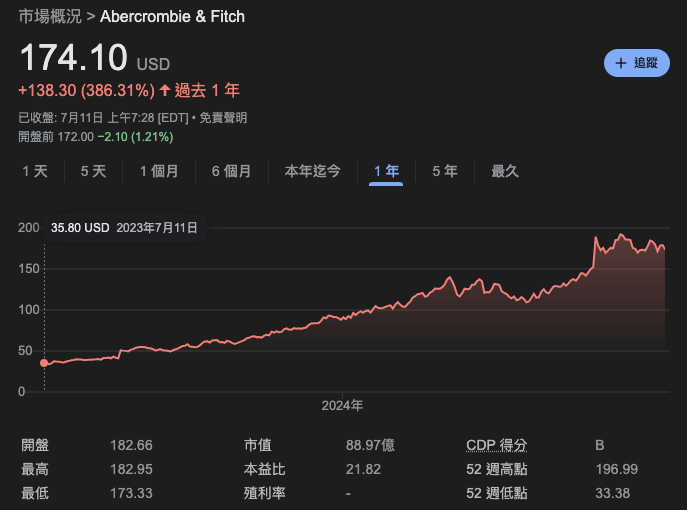Non-AI Popular Stocks! Notorious Abercrombie & Fitch Makes a Comeback with Revenue Surging 393%

Sexualization of men, workplace bullying, age discrimination, appearance discrimination, racial discrimination, and harassment of employees even involving human trafficking. Former CEO Mike Jeffries walked away with a $27 million retirement package upon departure, leaving behind a mess. The extremely problematic American retail clothing brand A&F has surprisingly been on the rise since the pandemic, standing out amidst the general trend of closures in the U.S. retail industry, defying experts' expectations. A&F has seen a staggering 393.20% revenue growth this year, with its stock price climbing to $174.40.

Table of Contents
A&F Brand Image Undergoes Multiple Overhauls
The predecessor of Abercrombie & Fitch was Abercrombie Co., founded in 1892 by David Abercrombie. Initially, David Abercrombie sold outdoor equipment with a rugged rural style, specializing in camping, fishing, and hunting gear. In 1904, a lawyer named Ezra Fitch acquired the majority of the company's stock and officially became a co-founder, renaming the company Abercrombie & Fitch.
In 1910, David Abercrombie left A&F. A&F opened a large department store on Madison Avenue in New York, selling men's and women's clothing, along with shooting ranges and golf schools. At this time, A&F adopted a high-end leisure approach.
A&F survived the Great Depression in 1920, but sales declined significantly by the mid-term. In 1977, it filed for bankruptcy and was later acquired by Limited Brands, leading to a deviation in its direction. The brand image began to revolve around sexual innuendos, objectification, and nudity, often featuring male Caucasian models in its ads. During this period, A&F's advertising and retail store focus was on muscular men, leading to a deteriorating company culture with supervisors overly concerned about the appearance of their employees.
Limited Brands is a large American retail group operated by Leslie Wexner, which also owns Victoria's Secret and Bath & Body Works. Victoria's Secret has filed for bankruptcy. Wexner had close ties with the sex trafficker Jeffrey Edward Epstein, leading to scrutiny by the U.S. government. Wexner gradually distanced himself from the brand. In 1990, Wexner hired Mike Jeffries as the CEO of A&F.
Jeffries made significant changes to the A&F brand image, with large billboard ads and shirtless male models becoming the highlights. A&F became a popular destination for teenage girls to take photos, resulting in long lines outside the stores every day as girls clamored to have pictures taken with the male models.
Jeffries faced continuous controversies and allegations of sexual harassment involving male models and employees. In October last year, a former male model accused Jeffries, during his 22-year tenure as CEO, of operating an illegal sex trafficking and human trafficking organization. According to the New York court complaint, Mike Jeffries was accused of hiring numerous scouts to lure young, good-looking men from the streets, bring them to mansions, force them to undress and take photos, transport them to various locations worldwide such as New York, Morocco, and the UK for fashion shows, and supply them to wealthy individuals. The court accepted the case on October 27, when A&F's stock price was only $59.
New Female CEO Turns the Tide with Brand MakeoverAfter Jeffries retired, A&F appointed Fran Horowitz-Bonadies as CEO. She had rich experience in purchasing at Saks and Bergdorf Goodman department stores.
Firstly, the objectification of men and suggestive brand image were removed, and black-and-white photos of male models no longer appeared on shopping bags. The brand's logo returned to a classic hunting image, targeting the millennial generation aged 28 to 43, shifting the consumer age group back. The clothing reverted to the traditional hunting high-end casual sportswear image from the founding era, introducing wedding dresses. The mature consumer base values materials, opts for softer high-end fabrics, and redesigned classic denim jeans, utilizing extensive market research to find the most suitable sizes for the millennial generation's body shapes, neither too tight nor too loose. The image tarnished by Jeffries transformed into a comfortable luxury brand, bringing A&F back to its former glory despised by consumers. The Wall Street Journal case study pointed out that A&F's growth outpaced H&M's during the AI boom.